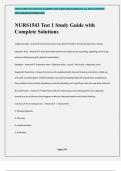EMILLYCHARLOTTE 2024/2025 ACADEMIC YAER ©2024 EMILLYCHARLOTTE. ALL RIGHTS RESERVED
FIRST PUBLISH SEPTEMBER 2024
NURS1543 Test 1 Study Guide with
Complete Solutions
Subjective Data - Answer✔✔-what the person says about himself or herself during history taking
Objective Data - Answer✔✔-what the health professional observes by inspecting, palpating, percussing,
and auscultating during the physical examination
Database - Answer✔✔-Subjective data + Objective data + record + lab results + diagnostic tests
Diagnostic Reasoning - Answer✔✔-process of analyzing health data and drawing conclusions. Made up
of 4 parts: (a) attending to initially available cues; (b) formulating diagnostic hypotheses; (c) gathering
data relative to the tentative hypotheses; and (d) evaluating each hypothesis with the new data collected
Nursing Process - Answer✔✔-Systematic method of planning and providing patient care organized
around a series of phrases that integrate evidence-informed practice and critical thinking.
5 phases of the nursing process - Answer✔✔-1. Assessment
2. Nursing Diagnosis
3. Planning
4. Implementation
5. Evaluation
Page 1/42
,EMILLYCHARLOTTE 2024/2025 ACADEMIC YAER ©2024 EMILLYCHARLOTTE. ALL RIGHTS RESERVED
FIRST PUBLISH SEPTEMBER 2024
First-level priority problems - Answer✔✔-emergent, life-threatening, and immediate, such as
establishing an airway or supporting breathing
Second-level priority problems - Answer✔✔-those that are next in urgency requiring your prompt
intervention to forestall further deterioration. (mental status change, acute pain, acute urinary
elimination problem, untreated medical problems, abnormal lab test results)
Third-level priority problems - Answer✔✔-those that are important to the patient's health but can be
addressed after more urgent health problems are addressed. (Knowledge deficit, altered family
processes, and low self esteem)
Collaborative problems - Answer✔✔-approach to treatment involves multiple disciplines
Evidence-informed practice - Answer✔✔-a paradigm and life-long problem solving approach to clinical
decision-making that involves the conscientious use of the best available evidence (including a
systematic search for and critical appraisal of the most relevant evidence to answer a clinical question)
with one's own clinical expertise and patient values and preferences to improve outcomes for
individuals, groups, communities, and systems
Biomedical model of health - Answer✔✔-Predominant model of the Canadian health care system, health
is the absence of disease.
Health and disease are viewed as two ends of a continuum. Disease is assumed to be caused by specific
agents or pathogens. Thus the biomedical focus is the diagnosis and treatment of those pathogens and
the curing of disease.
Page 2/42
,EMILLYCHARLOTTE 2024/2025 ACADEMIC YAER ©2024 EMILLYCHARLOTTE. ALL RIGHTS RESERVED
FIRST PUBLISH SEPTEMBER 2024
Behavioural Model of Health - Answer✔✔-health care extends beyond treating disease to include
secondary and primary preventions, with emphasis on changing behaviours and lifestyles
Socioenvironmental Model of Health - Answer✔✔-incorporates sociological and environmental aspects
in addition to the biomedical and behavioural ones.
Relational Approach in Nursing Practice - Answer✔✔-accounts for the fact that health, illness, and the
meanings they hold for a person are shaped by the person's social, cultural, family, historical, and
geographical contexts, as well as the person's gender, age, ability, and other individual contexts. Focuses
nurses' attention on what is significant to people in the context of their everyday lives and how
capacities and socioenvironmental limitations shape people's choices.
Complete (Total Health) Database - Answer✔✔-Includes complete health history and full physical
examination
Describes current and past health state and forms baseline to measure all future changes
Yields first diagnoses
episodic/problem centered database - Answer✔✔-limited, or short term problem
- collect a "mini" database, smaller in scope and more targeted.
Follow-up database - Answer✔✔-used in all settings to monitor progress of short-term or chronic health
problems. Evaluated the status of identified problems
Emergency database - Answer✔✔-rapid collection of the database, often compiled concurrently with
lifesaving measures
Page 3/42
, EMILLYCHARLOTTE 2024/2025 ACADEMIC YAER ©2024 EMILLYCHARLOTTE. ALL RIGHTS RESERVED
FIRST PUBLISH SEPTEMBER 2024
Periodic Health Examinations - Answer✔✔-Designed to prevent morbidity and mortality but identifying
modifiable risk factors and early signs of treatable conditions
primary prevention - Answer✔✔-People and populations are prevented from becoming ill, sick, or
injured in the first place
secondary prevention - Answer✔✔-early detection and treatment of disease
tertiary prevention - Answer✔✔-prevention of complications from an existing disease and promoting
health to the highest level
Health Promotion - Answer✔✔-"the process of enabling people to increase control over, and to improve
their health. It moves beyond a focus on individual behaviour towards a wide range of social and
environmental interventions." (WHO)
Disparities in health vs. Health Inequities - Answer✔✔-Disparities in Health occur when the combination
and interaction of the SDoH result in differences in health status between segments of the population.
When disparities are avoidable but outside the control of individuals, health inequities result.
Population Health Promotion Model - Answer✔✔-Multifaceted appraoch to considering the SDoH in our
nursing health assessment.
Culture - Answer✔✔-No single definition exists. In anthropology, culture is understood as an inherently
complex dimension of people's lives
Ethnicity - Answer✔✔-complex concept that can encompass multiple different aspects such as one's
country of origin or ancestry, identity, and family history, languages spoken, and, in some cases, religious
identity
Page 4/42




